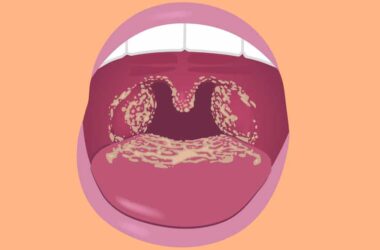The vagina contains bacteria and yeast in proper and suitable amounts and the balance of these two is one of the necessities of a healthy vagina.
When the normal balance of yeast and bacteria is disturbed, there is an overgrowth of yeast which causes the vaginal yeast infection.
Vaginal yeast infection is also called yeast vaginitis, candida vaginitis or candidal vulvovaginitis. The specific yeast that causes this infection is called Candida. Majority of the yeast infection, approximately 90 percent of it is caused by the species known as Candida albicans.
Vaginal yeast infections are very common and affects at least 75 percent of women at some point in life and many women experience at least two episodes.
Although they can bother you a lot, they are not usually serious, and treatment of these infections is very simple.
Table of Contents
- What causes Vaginal Yeast Infection?
- What are the signs and symptoms of a vaginal yeast infection?
- How Is Vaginal Yeast Infection Diagnosed?
- How is Vaginal Yeast Infection Treated?
- How To Prevent Vaginal Yeast Infections?
- Is Vaginal Yeast Infection Transmittable?
What causes Vaginal Yeast Infection?
As mentioned above, most yeast infections are caused by a type of yeast called Candida albicans. A healthy vagina has many bacteria and a small number of yeast cells.
Lactobacillus acidophilus is the most common bacteria and its presence helps keep other organisms like the yeast under control. It produces acid, which helps prevent the yeast overgrowth.
Disruption of the normal balance of bacteria quantity can therefore, lead to an increase in the vaginal yeast. Some things that cause the reduction of vaginal bacteria quantity would most probably lead to a vaginal yeast. Common causes of vaginal yeast infection are:
- Pregnancy: yeast infections are common during pregnancy due to an increase in estrogen levels. Treatment of the infection during pregnancy should be done with caution. Consult your doctors when the symptoms appear before using any medication.
- Taking antibiotics: when the protective bacteria, Lactobacillus acidophilus, are eradicated by antibiotics, which may be taken to treat a urinary tract, respiratory, or other types of infection, the yeast would be able to multiply, invade tissues, and cause the infection.
- Suppressed immune system: women with suppressed or impaired immune system, either due to stress or taking drugs such as cortisone-related medications like prednisone, develop vaginal yeast infections more frequently than women with normal immunity.
- Taking oral contraceptives or hormone therapy: oral contraceptives and hormone therapy work by tampering with the normal level of hormones and in most cases, increase estrogen levels which could lead one to have the infection.
- Injury to the inner vagina such as after chemotherapy.
- Some health problems such as HIV infection or uncontrolled diabetes.
The use of perfumed vaginal sprays, wipes, or douches may also increase a woman’s risk of developing a vaginal yeast infection.
What are the signs and symptoms of a vaginal yeast infection?
The symptoms can range from mild to moderate and they include:
- An intense itching and irritation in the genitals or vagina and the tissues of the vaginal opening, i.e. the vulva.
- A burning or painful sensation especially while urinating or during sexual intercourse.
- Redness, irritation, or soreness of the vagina or vulva in women; swelling of the vagina
- Watery vaginal discharge
- Thick, odorless, whitish-gray vaginal discharge. It could be described as having a cottage-cheese like appearance or consistency.
How Is Vaginal Yeast Infection Diagnosed?
For a proper diagnosis, consult your doctor. You should see your doctor when:
- This is the first time you have had these symptoms.
- You are not certain if it’s a vaginal yeast infection.
- If you are pregnant.
- If you develop other symptoms.
- If the symptoms don’t disappear after treating with over-the-counter anti-fungal vaginal creams or suppositories.
To make an accurate diagnosis, a sample of the discharge is tested either by culture or by direct examination under a microscope in the laboratory.
This is done to identify properly the yeast organisms and to help rule out other causes such as bacterial vaginosis or sexually transmitted diseases that may display the same symptoms.
How is Vaginal Yeast Infection Treated?
If you have had the infection before and you are certain from the symptoms that it is a vaginal yeast infection, you can treat yourself at home with some over-the-counter medications.
You can use an anti-fungal cream, a suppository that you put into your vagina, or anti-fungal tablets that you swallow. However, if you are pregnant, its best to go see the doctor before self-medication. If your symptoms are mild, you may want to wait to see if they clear up on their own.
If you use a cream or a suppository to treat your infection, do not depend on a condom or a diaphragm for birth control for a few days as the oil in some of these medicines could weaken latex, the material used to make these devices.
If you have more than four yeast infections in a year, see your doctor because this could be caused by another health problem such as diabetes.
How To Prevent Vaginal Yeast Infections?
Practicing a good genital hygiene can help prevent an infection. Some things to be done are:
- Keeping the genitals clean: use mild unscented soap and rinse well with clean water
- Wipe from front to back and not back to front after using the toilet to avoid spreading yeast or bacteria from your anus to your vagina or urinary tract.
- Avoid tight fitting clothing as this could increase moisture in your genital area.
- Wear cotton underwear or underwear with cotton crotch as this would help keep your genital area dry because it does not hold in warmth and moisture.
- Change pads and tampons often.
- Change out of wet swimsuits right away to keep your genitals away from moisture.
- Do not use deodorant tampons, feminine sprays, douche, powders or perfumes because these items can change the vaginal pH and normal balance of organisms in your vagina.
- Stay our of hot tubs and very hot baths.
Is Vaginal Yeast Infection Transmittable?
Yes, yeast infections are transmittable. A yeast infection might happen after certain sexual activities, especially after oral sex. It is usually in the form of irritation and itching of the penis of men who have had sexual contact with infected women.
Treatment of make sexual partners is not considered necessary unless the man develops symptoms.
Although it can be transmitted through sex, most experts do not consider yeast infection to be a sexually transmitted disease. This is because even women who aren’t sexually active can develop yeast infections.






